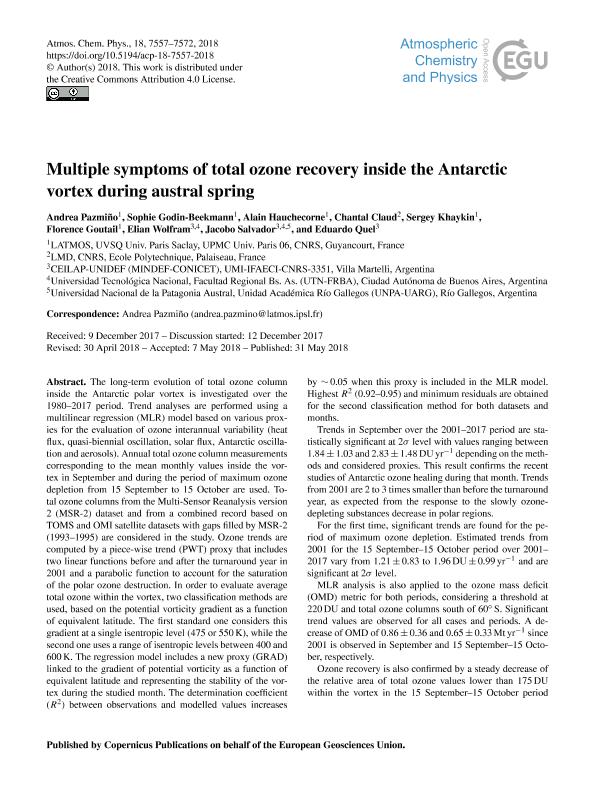Mostrar el registro sencillo del ítem
dc.contributor.author
Pazmino, Andrea
dc.contributor.author
Godin Beekmann, Sophie
dc.contributor.author
Hauchecorne, Alain
dc.contributor.author
Claud, Chantal
dc.contributor.author
Khaykin, Sergey
dc.contributor.author
Goutail, Florence
dc.contributor.author
Wolfram, Elian Augusto

dc.contributor.author
Salvador, Jacobo Omar

dc.contributor.author
Quel, Eduardo Jaime

dc.date.available
2018-04-10T13:36:13Z
dc.date.issued
2017-12
dc.identifier.citation
Pazmino, Andrea; Godin Beekmann, Sophie; Hauchecorne, Alain; Claud, Chantal; Khaykin, Sergey; et al.; Multiple symptoms of total ozone recovery inside the Antarctic vortex during austral spring; Copernicus; Atmospheric Chemistry and Physics Discussions; 12-2017; 1-28
dc.identifier.issn
1680-7375
dc.identifier.uri
http://hdl.handle.net/11336/41475
dc.description.abstract
The long-term evolution of total ozone column inside the Antarctic polar vortex is investigated over the 1980-2016 period. Trend analyses are performed using a multilinear regression (MLR) model based on various proxies (heat flux, QBO, solar flux, AAO and aerosols). Annual total ozone column corresponding to the mean monthly values inside the vortex in September and during the period of maximum ozone depletion from September 15th to October 15th are used. Total ozone columns from combined TOMS-N7, SBUV-N9, TOMS-EP and OMI-TOMS satellite datasets and the Multi-Sensor Reanalysis (MRS-2) dataset are considered in the study. Ozone trends are computed by a piecewise trend model (PWT) before and after the turnaround in 2001. In order to evaluate total ozone within the vortex, two classification methods are used, based on the potential vorticity gradient as a function of equivalent latitude. The first standard one, considers this gradient at a single isentropic level (475K or 550K), while the second one uses a range of isentropic levels between 400K and 600K. The regression model includes a new proxy that represents the stability of the vortex during the studied month period. The determination coefficient (R2) between observations and modeled values increases by ~0.05 when this proxy is included in the MLR model. The higher R2 (0.93-0.95) and the minimum residuals are found for the second classification method in the case of both datasets and months periods. Trends in September are statistically significant at 2 sigma level with values ranging between 1.85 and 2.67 DU yr-1 depending on the methods and data sets. This result confirms the recent studies of Antarctic ozone healing during that month. Trends after 2001 are 2 to 3 times lower than before the turnaround year as expected from the response to the slowly ODS decrease in Polar regions.Estimated trends in the 15Sept-15Oct period are smaller than in September. They vary from 1.15 to 1.78 DU yr-1 and are hardly significant at 2 level. Ozone recovery is also confirmed by a steady decrease of the relative area of total ozone values lower than 150 DU within the vortex in the 15Sept-15Oct period since 2010. Comparison of the evolution of the ozone hole area in September and October show a decrease in September, confirming the later formation of the ozone hole during that month.
dc.format
application/pdf
dc.language.iso
eng
dc.publisher
Copernicus
dc.rights
info:eu-repo/semantics/openAccess
dc.rights.uri
https://creativecommons.org/licenses/by-nc-sa/2.5/ar/
dc.subject
Ozone
dc.subject
Antartic
dc.subject
Recovery
dc.subject.classification
Meteorología y Ciencias Atmosféricas

dc.subject.classification
Ciencias de la Tierra y relacionadas con el Medio Ambiente

dc.subject.classification
CIENCIAS NATURALES Y EXACTAS

dc.title
Multiple symptoms of total ozone recovery inside the Antarctic vortex during austral spring
dc.type
info:eu-repo/semantics/article
dc.type
info:ar-repo/semantics/artículo
dc.type
info:eu-repo/semantics/publishedVersion
dc.date.updated
2018-04-09T15:19:52Z
dc.journal.pagination
1-28
dc.journal.pais
Alemania

dc.journal.ciudad
Katlenburg-Lindau
dc.description.fil
Fil: Pazmino, Andrea. Universidad Paris Saclay; Francia
dc.description.fil
Fil: Godin Beekmann, Sophie. Universidad Paris Saclay; Francia
dc.description.fil
Fil: Hauchecorne, Alain. Universidad Paris Saclay; Francia
dc.description.fil
Fil: Claud, Chantal. Ecole Polytechnique; Francia
dc.description.fil
Fil: Khaykin, Sergey. Universidad Paris Saclay; Francia
dc.description.fil
Fil: Goutail, Florence. Universidad Paris Saclay; Francia
dc.description.fil
Fil: Wolfram, Elian Augusto. Consejo Nacional de Investigaciones Científicas y Técnicas. Instituto de Investigaciones Científicas y Técnicas para la Defensa. Centro de Investigación en Láseres y Aplicaciones; Argentina. Consejo Nacional de Investigaciones Científicas y Técnicas. Unidad de Investigación y Desarrollo Estratégico para la Defensa. Ministerio de Defensa. Unidad de Investigación y Desarrollo Estratégico para la Defensa; Argentina. Ministerio de Defensa; Argentina
dc.description.fil
Fil: Salvador, Jacobo Omar. Consejo Nacional de Investigaciones Científicas y Técnicas. Instituto de Investigaciones Científicas y Técnicas para la Defensa. Centro de Investigación en Láseres y Aplicaciones; Argentina. Consejo Nacional de Investigaciones Científicas y Técnicas. Unidad de Investigación y Desarrollo Estratégico para la Defensa. Ministerio de Defensa. Unidad de Investigación y Desarrollo Estratégico para la Defensa; Argentina. Ministerio de Defensa; Argentina. Universidad Tecnológica Nacional. Facultad Regional Buenos Aires; Argentina. Universidad Nacional de la Patagonia Austral; Argentina
dc.description.fil
Fil: Quel, Eduardo Jaime. Consejo Nacional de Investigaciones Científicas y Técnicas. Instituto de Investigaciones Científicas y Técnicas para la Defensa. Centro de Investigación en Láseres y Aplicaciones; Argentina. Ministerio de Defensa; Argentina. Consejo Nacional de Investigaciones Científicas y Técnicas. Unidad de Investigación y Desarrollo Estratégico para la Defensa. Ministerio de Defensa. Unidad de Investigación y Desarrollo Estratégico para la Defensa; Argentina
dc.journal.title
Atmospheric Chemistry and Physics Discussions
dc.relation.alternativeid
info:eu-repo/semantics/altIdentifier/doi/https://doi.org/10.5194/acp-18-7557-2018
dc.relation.alternativeid
info:eu-repo/semantics/altIdentifier/url/https://www.atmos-chem-phys.net/18/7557/2018/
Archivos asociados
